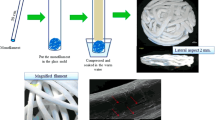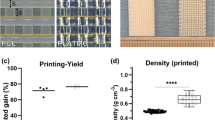Abstract
The integration of precision medicine principles into bone tissue engineering has ignited a wave of research focused on customizing intricate scaffolds through advanced 3D printing techniques. Bioceramics, known for their exceptional biocompatibility and osteoconductivity, have emerged as a promising material in this field. This article aims to evaluate the regenerative capabilities of a composite scaffold composed of 3D-printed gelatin combined with hydroxyapatite/tricalcium phosphate bioceramics (G/HA/TCP), incorporating human dental pulp–derived stem cells (hDPSCs). Using 3D powder printing, we created cross-shaped biphasic calcium phosphate scaffolds with a gelatin layer. The bone-regenerating potential of these scaffolds, along with hDPSCs, was assessed through in vitro analyses and in vivo studies with 60 rats and critical-sized calvarial defects. The assessment included analyzing cellular proliferation, differentiation, and alkaline phosphatase activity (ALP), and concluded with a detailed histological evaluation of bone regeneration. Our study revealed a highly favorable scenario, displaying not only desirable cellular attachment and proliferation on the scaffolds but also a notable enhancement in the ALP activity of hDPSCs, underscoring their pivotal role in bone regeneration. However, the histological examination of calvarial defects at the 12-wk mark yielded a rather modest level of bone regeneration across all experimental groups. The test and cell group exhibited significant bone formation compared to all other groups except the control and cell group. This underscores the complexity of the regenerative process and paves the way for further in-depth investigations aimed at improving the potential of the composite scaffolds.






Similar content being viewed by others
Data Availability
Data available upon request.
References
Abbas Z, Dapporto M, Tampieri A, Sprio S (2021) Toughening of bioceramic composites for bone regeneration. J Compos Sci 5(10):259
Abbasi N, Hamlet S, Love RM, Nguyen N-T (2020) Porous scaffolds for bone regeneration. J Sci: Adv Mater Devices 5(1):1–9. https://doi.org/10.1016/j.jsamd.2020.01.007
Ahmadi A, Mazloomnejad R, Kasravi M, Gholamine B, Bahrami S, Sarzaeem MM, Niknejad H (2022) Recent advances on small molecules in osteogenic differentiation of stem cells and the underlying signaling pathways. Stem Cell Res Ther 13(1):518. https://doi.org/10.1186/s13287-022-03204-4
Assadian H, Khojasteh A, Ebrahimian Z, Ahmadinejad F, Boroojeni HSH, Bohlouli M, Nekoofar MH, MhDummer P, Nokhbatolfoghahaei H (2022) Comparative evaluation of the effects of three hydraulic calcium silicate cements on odontoblastic differentiation of human dental pulp stem cells: an in vitro study. J Appl Oral Sci 30:e20220203. https://doi.org/10.1590/1678-7757-2022-0203
Bahraminasab M (2020) Challenges on optimization of 3D-printed bone scaffolds. Biomed Eng Online 19(1):69. https://doi.org/10.1186/s12938-020-00810-2
Chen X, Gao CY, Chu XY, Zheng CY, Luan YY, He X, Yang K, Zhang DL (2022) VEGF-loaded heparinised gelatine-hydroxyapatite-tricalcium phosphate scaffold accelerates bone regeneration via enhancing osteogenesis-angiogenesis coupling. Front Bioeng Biotechnol 10:915181. https://doi.org/10.3389/fbioe.2022.915181
Deng F, Liu L, Li Z, Liu J (2021) 3D printed Ti6Al4V bone scaffolds with different pore structure effects on bone ingrowth. J Biol Eng 15(1):4. https://doi.org/10.1186/s13036-021-00255-8
Edrees HY, Abu Zeid STH, Atta HM, AlQriqri MA (2019) Induction of osteogenic differentiation of mesenchymal stem cells by bioceramic root repair material. Materials (Basel) 12(14):2311. https://doi.org/10.3390/ma12142311
Ergun A, Yu X, Valdevit A, Ritter A, Kalyon DM (2012) Radially and axially graded multizonal bone graft substitutes targeting critical-sized bone defects from polycaprolactone/hydroxyapatite/tricalcium phosphate. Tissue Eng Part A 18(23–24):2426–2436. https://doi.org/10.1089/ten.TEA.2011.0625
Fatemeh B, Maryam V, Armin A, Farangis N, Bita A, Ehsan S-P (2022) Evaluation of immunomodulatory effects of co-culture or supernatant of dexamethasone or IFN-γ-treated adipose-derived mesenchymal stem cells on spleen mononuclear cells. Eur Cytokine Netw 33(3):70–78. https://doi.org/10.1684/ecn.2022.0482
Garcia-Urkia N, Luzuriaga J, Uribe-Etxebarria V, Irastorza I, Fernandez-San-Argimiro FJ, Olalde B, Briz N, Unda F, Ibarretxe G, Madarieta I, Pineda JR (2022) Enhanced adipogenic differentiation of human dental pulp stem cells in enzymatically decellularized adipose tissue solid foams. Biology (Basel) 11(8):1099. https://doi.org/10.3390/biology11081099
Gu Y, Bai Y, Zhang D (2018) Osteogenic stimulation of human dental pulp stem cells with a novel gelatin-hydroxyapatite-tricalcium phosphate scaffold. J Biomed Mater Res A 106(7):1851–1861. https://doi.org/10.1002/jbm.a.36388
Guan L, Davies JE (2004) Preparation and characterization of a highly macroporous biodegradable composite tissue engineering scaffold. J Biomed Mater Res Part A 71A(3):480–487. https://doi.org/10.1002/jbm.a.30173
Guo F, Huang K, Niu J, Kuang T, Zheng Y, Gu Z, Zou J (2020) Enhanced osseointegration of double network hydrogels via calcium polyphosphate incorporation for bone regeneration. Int J Biol Macromol 151:1126–1132. https://doi.org/10.1016/j.ijbiomac.2019.10.155
Hassan MN, Yassin MA, Suliman S, Lie SA, Gjengedal H, Mustafa K (2019) The bone regeneration capacity of 3D-printed templates in calvarial defect models: a systematic review and meta-analysis. Acta Biomater 91:1–23. https://doi.org/10.1016/j.actbio.2019.04.017
Hojabri M, Tayebi T, Kasravi M, Aghdaee A, Ahmadi A, Mazloomnejad R, Tarasi R, Shaabani A, Bahrami S, Niknejad H (2023) Wet-spinnability and crosslinked fiber properties of alginate/hydroxyethyl cellulose with varied proportion for potential use in tendon tissue engineering. Int J Biol Macromolecules 240:124492. https://doi.org/10.1016/j.ijbiomac.2023.124492
Hong M-H, Lee JH, Jung HS, Shin H, Shin H (2022) Biomineralization of bone tissue: calcium phosphate-based inorganics in collagen fibrillar organic matrices. Biomaterials Research 26(1):42. https://doi.org/10.1186/s40824-022-00288-0
Jenndahl L, Österberg K, Bogestål Y, Simsa R, Gustafsson-Hedberg T, Stenlund P, Petronis S, Krona A, Fogelstrand P, Strehl R, Håkansson J (2022) Personalized tissue-engineered arteries as vascular graft transplants: a safety study in sheep. Regen Ther 21:331–341. https://doi.org/10.1016/j.reth.2022.08.005
Kasravi M, Ahmadi A, Babajani A, Mazloomnejad R, Hatamnejad MR, Shariatzadeh S, Bahrami S, Niknejad H (2023) Immunogenicity of decellularized extracellular matrix scaffolds: a bottleneck in tissue engineering and regenerative medicine. Biomaterials Research 27(1):10. https://doi.org/10.1186/s40824-023-00348-z
Khalaf AT, Wei Y, Wan J, Zhu J, Peng Y, Abdul Kadir SY, Zainol J, Oglah Z, Cheng L, Shi Z (2022) Bone tissue engineering through 3D bioprinting of bioceramic scaffolds: a review and update. Life (Basel) 12(6):903. https://doi.org/10.3390/life12060903
Kon E, Salamanna F, Filardo G, Di Matteo B, Shabshin N, Shani J, Fini M, Perdisa F, Parrilli A, Sprio S, Ruffini A, Marcacci M, Tampieri A (2021) Bone regeneration in load-bearing segmental defects, guided by biomorphic, hierarchically structured apatitic scaffold [original research]. Front Bioeng Biotechnol 9. https://www.frontiersin.org/articles/10.3389/fbioe.2021.734486
Kwon SG, Kwon YW, Lee TW, Park GT, Kim JH (2018) Recent advances in stem cell therapeutics and tissue engineering strategies. Biomater Res 22(1):36. https://doi.org/10.1186/s40824-018-0148-4
Liu Y, Zhao Q, Chen C, Wu C, Ma Y (2022) β-Tricalcium phosphate/gelatin composite scaffolds incorporated with gentamycin-loaded chitosan microspheres for infected bone defect treatment. PLoS ONE 17(12):e0277522. https://doi.org/10.1371/journal.pone.0277522
Mazloomnejad R, Babajani A, Kasravi M, Ahmadi A, Shariatzadeh S, Bahrami S, Niknejad H (2023) Angiogenesis and re-endothelialization in decellularized scaffolds: recent advances and current challenges in tissue engineering. Front Bioeng Biotechnol 11:1103727. https://doi.org/10.3389/fbioe.2023.1103727
Mohaghegh S, Baniameri S, Khojasteh A (2023) Rapid prototyping models in oral and maxillofacial surgery: history, definition, and indications. In: Khojasteh A, Ayoub AF, Nadjmi N (eds) Emerging technologies in oral and maxillofacial surgery. Springer Nature Singapore, pp 77–84. https://doi.org/10.1007/978-981-19-8602-4_5
Monterubbianesi R, Bencun M, Pagella P, Woloszyk A, Orsini G, Mitsiadis TA (2019) A comparative in vitro study of the osteogenic and adipogenic potential of human dental pulp stem cells, gingival fibroblasts and foreskin fibroblasts. Sci Rep 9(1):1761. https://doi.org/10.1038/s41598-018-37981-x
Park SA, Lee H-J, Kim S-Y, Kim K-S, Jo D-W, Park S-Y (2021) Three-dimensionally printed polycaprolactone/beta-tricalcium phosphate scaffold was more effective as an rhBMP-2 carrier for new bone formation than polycaprolactone alone. J Biomed Mater Res Part A 109(6):840–848. https://doi.org/10.1002/jbm.a.37075
Rai B, Lin JL, Lim ZX, Guldberg RE, Hutmacher DW, Cool SM (2010) Differences between in vitro viability and differentiation and in vivo bone-forming efficacy of human mesenchymal stem cells cultured on PCL-TCP scaffolds. Biomaterials 31(31):7960–7970. https://doi.org/10.1016/j.biomaterials.2010.07.001
Ratheesh G, Shi M, Lau P, Xiao Y, Vaquette C (2021) Effect of dual pore size architecture on in vitro osteogenic differentiation in additively manufactured hierarchical scaffolds. ACS Biomater Sci Eng 7(6):2615–2626. https://doi.org/10.1021/acsbiomaterials.0c01719
Safiaghdam H, Nokhbatolfoghahaei H, Farzad-Mohajeri S, Dehghan MM, Farajpour H, Aminianfar H, Bakhtiari Z, Jabbari Fakhr M, Hosseinzadeh S, Khojasteh A (2023) 3D-printed MgO nanoparticle loaded polycaprolactone β-tricalcium phosphate composite scaffold for bone tissue engineering applications: in-vitro and in-vivo evaluation. J Biomed Mater Res Part A 111(3):322–339. https://doi.org/10.1002/jbm.a.37465
Salvador-Clavell R, Martín de Llano JJ, Milián L, Oliver M, Mata M, Carda C, Sancho-Tello M (2021) Chondrogenic potential of human dental pulp stem cells cultured as microtissues. Stem Cells Int 2021:7843798. https://doi.org/10.1155/2021/7843798
Samanipour R, Farzaneh S, Ranjbari J, Hashemi S, Khojasteh A, Hosseinzadeh S (2023) Osteogenic differentiation of pulp stem cells from human permanent teeth on an oxygen-releasing electrospun scaffold. Polym Bull 80(2):1795–1816. https://doi.org/10.1007/s00289-022-04145-x
Shi F, Xiao D, Zhang C, Zhi W, Liu Y, Weng J (2021) The effect of macropore size of hydroxyapatite scaffold on the osteogenic differentiation of bone mesenchymal stem cells under perfusion culture. Regen Biomater 8(6):rbab050. https://doi.org/10.1093/rb/rbab050
Shor L, Güçeri S, Wen X, Gandhi M, Sun W (2007) Fabrication of three-dimensional polycaprolactone/hydroxyapatite tissue scaffolds and osteoblast-scaffold interactions in vitro. Biomaterials 28(35):5291–5297. https://doi.org/10.1016/j.biomaterials.2007.08.018
Sun F, Wang T, Yang Y (2022) Hydroxyapatite composite scaffold for bone regeneration via rapid prototyping technique: a review. Rapid Prototyp J 28(3):585–605. https://doi.org/10.1108/RPJ-09-2020-0224
Tan H, Wu J, Lao L, Gao C (2009) Gelatin/chitosan/hyaluronan scaffold integrated with PLGA microspheres for cartilage tissue engineering. Acta Biomater 5(1):328–337. https://doi.org/10.1016/j.actbio.2008.07.030
Wang C, Huang W, Zhou Y, He L, He Z, Chen Z, He X, Tian S, Liao J, Lu B, Wei Y, Wang M (2020a) 3D printing of bone tissue engineering scaffolds. Bioact Mater 5(1):82–91. https://doi.org/10.1016/j.bioactmat.2020.01.004
Wang F, Guo Y, Lv R, Xu W, Wang W (2020b) Development of nano-tricalcium phosphate/polycaprolactone/platelet-rich plasma biocomposite for bone defect regeneration. Arab J Chem 13(9):7160–7169. https://doi.org/10.1016/j.arabjc.2020.07.021
Wu L, Xue K, Hu G, Du H, Gan K, Zhu J, Du T (2021) Effects of iRoot SP on osteogenic differentiation of human stem cells from apical papilla. BMC Oral Health 21(1):407. https://doi.org/10.1186/s12903-021-01769-9
Xu H, Wang C, Liu C, Li J, Peng Z, Guo J, Zhu L (2022) Stem cell-seeded 3D-printed scaffolds combined with self-assembling peptides for bone defect repair. Tissue Eng Part A 28(3–4):111–124. https://doi.org/10.1089/ten.TEA.2021.0055
Yao YT, Yang Y, Ye Q, Cao SS, Zhang XP, Zhao K, Jian Y (2021) Effects of pore size and porosity on cytocompatibility and osteogenic differentiation of porous titanium. J Mater Sci Mater Med 32(6):72. https://doi.org/10.1007/s10856-021-06548-0
Yin H, Zhu M, Wang Y, Luo L, Ye Q, Lee BH (2023) Physical properties and cellular responses of gelatin methacryloyl bulk hydrogels and highly ordered porous hydrogels. Frontiers in Soft Matter 2:1101680
Yuan B, Zhou SY, Chen XS (2017) Rapid prototyping technology and its application in bone tissue engineering. J Zhejiang Univ Sci B 18(4):303–315. https://doi.org/10.1631/jzus.B1600118
Yuan Y, Yuan Q, Wu C, Ding Z, Wang X, Li G, Gu Z, Li L, Xie H (2019) Enhanced osteoconductivity and osseointegration in calcium polyphosphate bioceramic scaffold via lithium doping for bone regeneration. ACS Biomater Sci Eng 5(11):5872–5880. https://doi.org/10.1021/acsbiomaterials.9b00950
Zaszczyńska A, Moczulska-Heljak M, Gradys A, Sajkiewicz P (2021) Advances in 3D printing for tissue engineering. Materials (Basel) 14(12):3149. https://doi.org/10.3390/ma14123149
Zhuang H, Lin R, Liu Y, Zhang M, Zhai D, Huan Z, Wu C (2019) Three-dimensional-printed bioceramic scaffolds with osteogenic activity for simultaneous photo/magnetothermal therapy of bone tumors. ACS Biomater Sci Eng 5(12):6725–6734. https://doi.org/10.1021/acsbiomaterials.9b01095
Acknowledgements
L. T. acknowledges the partial support from National Institute of Dental & Craniofacial Research of the National Institutes of Health under award numbers R56 DE029191 and R15DE027533.
Author information
Authors and Affiliations
Corresponding authors
Rights and permissions
Springer Nature or its licensor (e.g. a society or other partner) holds exclusive rights to this article under a publishing agreement with the author(s) or other rightsholder(s); author self-archiving of the accepted manuscript version of this article is solely governed by the terms of such publishing agreement and applicable law.
About this article
Cite this article
Safiaghdam, H., Baniameri, S., Aminianfar, H. et al. Evaluating osteogenic potential of a 3D-printed bioceramic-based scaffold for critical-sized defect treatment: an in vivo and in vitro investigation. In Vitro Cell.Dev.Biol.-Animal (2024). https://doi.org/10.1007/s11626-024-00912-4
Received:
Accepted:
Published:
DOI: https://doi.org/10.1007/s11626-024-00912-4




